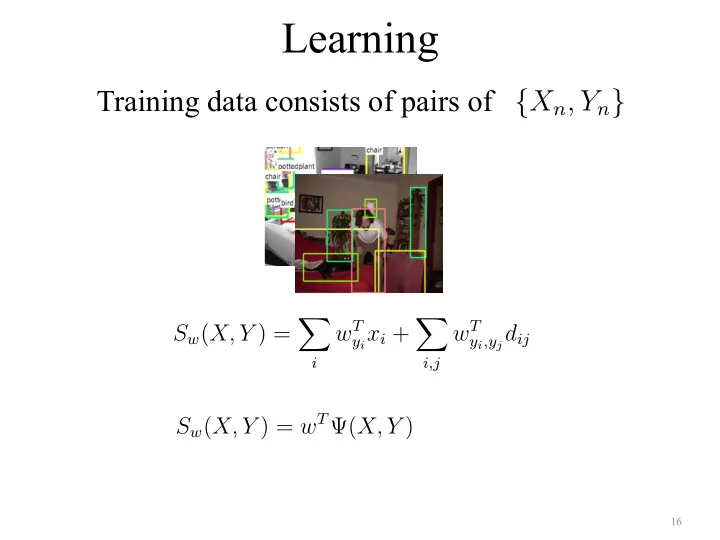

Learning Training data consists of pairs of { X n , Y n } � � w T w T S w ( X, Y ) = y i x i + y i ,y j d ij i i,j S w ( X, Y ) = w T Ψ ( X, Y ) 16
Learning with SVMs 1 2 w T w argmin w w T Ψ ( X n , Y n ) − w T Ψ ( X n , H n ) ≥ 1 s . t . ∀ n, H n � = Y n “Find a small w such that for each image, score of true label Y n dominates all other hypothesized labels H n by at least 1 unit” Y n H n Only a tiny fraction of exponential number of constraints are necessary (i.e., support vectors) Structured Prediction Tsochantaridis et al. ICML 04
Experiments 1) We use PASCAL 2007 training and test data 20 classes, 5000 training images, 5000 test images 2) Baseline: Felzenswalb et al. PAMI 09 (with default NMS) 3) Local feature = [score of baseline detector 1] (We learn bias and offset for each local detector) 4) Pairwise feature + 50% overlap feature 18
Overlap feature in pairwise potential Mutual exclusion can be subtle Parameters are trained with knowledge of local detectors
Remaining pairwise potentials
Results Top 10 detections for baseline Our top 10 detections Favor Inhibit overlapping people & bottles overlapping people & sofas because local detectors confuse them because people sit on sofas
Results Baseline Our model
Default NMS heuristics Default heuristics don’t work for Mutual Exclusion Winning Felzenszwalb et al. Mutual Our PASCAL07 PAMI 09 Exclusion model score code plane .262 0.278 0.270 0.288 bike .409 0.559 0.444 0.562 bird .098 0.014 0.015 0.032 boat .094 0.125 0.142 0.146 bottle .214 0.257 0.185 0.294 bus 0.381 0.299 0.387 .393 car .432 0.470 0.466 0.487 cat .240 0.151 0.133 0.124 chair .128 0.145 0.160 0.163 cow .140 0.167 0.109 0.177 table .098 0.228 0.191 0.240 dog .162 0.111 0.091 0.117 horse .335 0.438 0.371 0.450 motbike .375 0.373 0.325 0.394 person .221 0.352 0.342 0.355 plant .120 0.140 0.091 0.152 sheep 0.169 0.091 0.161 .175 sofa .147 0.193 0.188 0.201 train .334 0.319 0.318 0.342 TV .289 0.359 0.354 0.373 Our model outperforms Felzenszwalb et al.’s baseline for most classes
Alternate scores for multiclass detection Building a ‘drinking detector’ requires finding people and bottles simultaneously Per-class AP’s don’t score this Under more appropriate scoring criteria, our model does significantly better (see paper) 24
Recommend
More recommend